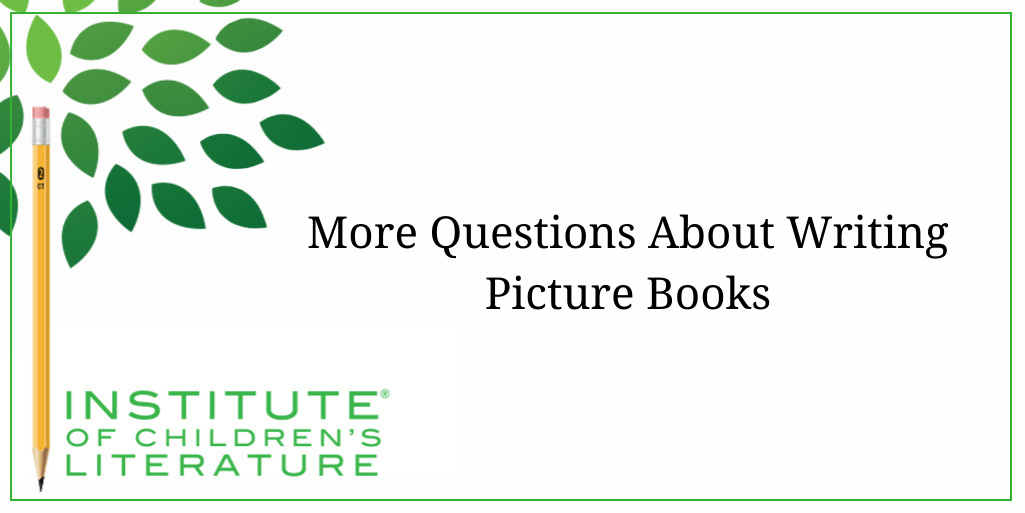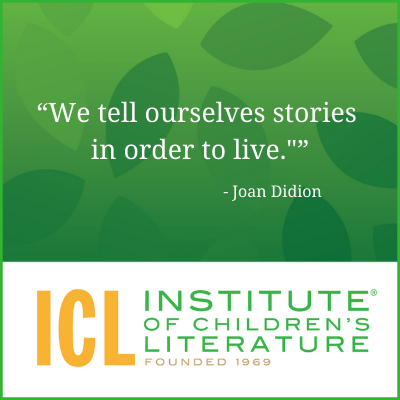
5 Ways Writers Can Prep for 2025 Goal Setting
Before we roll on to the new writing year, let’s harness our optimism for the blank slate before us and prepare for our 2025 Goal Setting just for writers.

We teach our students how to write and get published!
View our Course Catalog >
Even though picture books are probably the most easily identified of all the “children’s books,” they still produce plenty of questions. For some, the changes picture books have gone through over time prompt questions. For others, the questions are mostly about selling. So let’s answer four burning questions today about writing picture books.
Although this seems like a simple question, it’s surprisingly complex. First, not all picture books published today adhere to the 500 words or less rule that you’ve probably heard. Flashlight Press, for example, is interested in picture books that are under 1,000 words. Though presently only accepting materials through agents, Peachtree also publishes picture books of 1000 words or longer. Charlesbridge has also published longer picture books. In fact, nonfiction picture books from nearly all picture book publishers are often longer than 500 words, especially when informational back matter is included.

Also, picture books now target younger children than they once did. Though you’ll see picture books in school libraries, fluent readers will often avoid them, seeing picture books as “babyish.” And parents also tend to shy away from picture books for school-aged children, choosing easy readers or early chapter books instead to encourage children to read for themselves. This isn’t true of every parent or every young reader, of course, but it’s true of enough of them that publishers have adjusted to create books with the greatest chance of selling.
Although these elements of writing picture books affect choices made by publishers, they’re rather sad. Picture books expose young children to such rich, vibrant language, allowing them to learn and use a far more expansive vocabulary than they would encounter in easy readers or early chapter books. Limiting school-aged children to books they are able to decode cuts out all of that gorgeous, challenging language found in picture books. Plus, studies show that the more a child is read to, the better school success they tend to have, so parents who continue to read picture books aloud through the early elementary years often have children who are better prepared for reading challenges later.
Many publishers publish books that are written in metered verse. And many new writers think of the beautiful rhyming texts they’ve read to their own children and loved. This fills new writers with the urge to write picture book stories in rhyme. But rhyming picture books carry the added burden of meter—in other words, the stressed and unstressed syllables in the text have to follow a consistent pattern—and that’s a huge challenge to lay on top of the existing challenges of writing a unique story with lively characters and a meaningful point. Some writers have an amazing natural ear for meter and metrical language. For them, the process of writing in rhyme is far easier than for folks like me. But few writers start off with much understanding of metrical language.
Unfortunately, the ability to write metered text is one of those things that people have trouble properly gauging in themselves. I’ve heard new writers say that a picture book text “just flowed” and that it had to be told in rhyme. But when the text is read aloud by someone who didn’t write it, the problems with the meter jump out. It makes the book sound clunky and it makes readers stumble when reading it.
Good, consistent meter actually makes reading aloud easier. Poor meter makes it harder than prose that is simply written the way people speak. Why couldn’t the writer tell the meter wasn’t right? It’s usually because the writer forced the meter to work when reading it aloud and stressed the syllables that would not normally be stressed in order to make the meter sound right. But parents coming upon the text for the first time would not do that. They will follow the stresses that are normal to the words and sentences, and it will make reading the book harder and less enjoyable.
This is one reason why you should always have someone else read your picture book manuscript aloud to you, so you can find spots where the language is clunky and the reading is awkward. You’ll spot it so much easier when listening to someone read to you.
One reason publishers don’t like rhyming books from writers they don’t know is because of poor meter, but it’s not the only reason. Even writers with a natural ear for meter will sometimes end up throwing in sentences that don’t make sense with the rest of the book in order to make the rhyme scheme work out. Also, the challenge of writing in rhyme is so great, that plot, characterization, action, and structure can all suffer as the writer puts total focus on rhyme and meter.
The truth is that publishers love good metered, rhyming stories, but they’ve gotten so many bad examples in submissions that they have simply banned the form from anyone who doesn’t have an agent (as they assume an agent would weed out the problem texts for them). If you know you’re a person who writes metered, rhyming books well, you may want to begin your search for a good agent.
Many times in the past, I’ve told picture book writers that they did not need an agent. Most publishers of picture books allowed manuscript submissions from writers directly. Today, that’s far less true. Sure, some publishers are still open to hearing from writers, but many have found the extra step of requiring agents lessens their submissions load and improves the quality of the submissions they receive. However, even with these “closed” houses, writers can watch for appearances by editors from these houses at writing conferences or writing workshops. In these settings, attendees are often given a “free pass” to submit directly to the editors for a limited time. This can be a great option when you’re absolutely certain that your picture book would be the perfect match with a specific publishing company’s style and existing line.
Sometimes publishers have limited open submissions times. This helps avoid a flood of submissions the publishing staff cannot handle, but still opens a window long enough for new voices to slip through. Publishers are always interested in catching the manuscript from a new, exciting writer,or a story that will capture the hearts of readers and become a new classic in the making. Because of this, short open submissions windows are becoming more common.
In today’s market, writers basically have four possible paths:
Some participate regularly in twitter pitch events, allowing you to catch the agent’s attention with a short, exciting pitch for your book. You can also find agents and their submissions guidelines in our market guides. If you do go in search of an agent, know this: good agents do not charge writers money. Agents make their money by selling your manuscript to a publisher and getting a cut of the money from that. As a writer, if an agent ever asks you to write a check for office expenses (or reading fees or pretty much anything else), walk away and find a different agent. There are plenty of good ones out there.
Another frequent “rule” writers hear is that they should never include art notes in their picture book manuscripts. Art notes are instructions directed at the illustrator that explain how the art on a particular page should look. Art notes are mostly not needed or useful. Publishers actually want illustrators to bring their own storytelling skills to the book. But that doesn’t mean art notes can never be necessary.
Sometimes art notes can help considerably if you have an important thematic element that needs to be highlighted in the illustrations for the book to make sense, or if some element of the book might be confusing. For example, if the text talks about a character who went on an adventure with “Claire,” the immediate assumption is that Claire is another character. But what if Claire is a doll the child takes everywhere with her? It’s going to result in a totally different understanding of the text to have that information up front, and you’ll be able to avoid being scolded if Claire ends up in danger, for instance. In this case, a simple art note letting the editor and, eventually the illustrator, know that Claire is a doll will be helpful. The note wouldn’t describe Claire. That would be up to the illustrator. The note would simply be there for clarity.
The things editors want to avoid is having the writer try to manage the illustrator through notes. The reality is those notes will never reach the illustrator. If the publisher likes the book’s story enough to overcome the annoyance of too many art notes, the editor will simply strip the manuscript of pointless art notes before it’s handed over to the illustrator. So limit notes to only what it is needed to make the story clear.
Were you harboring any of these questions? If so, I hope you found some answers here. We’ll dive deeper into the world of writing picture books as we move through the month. I hope you’ll come along. It should be a blast.
With over 100 books in publication, Jan Fields writes both chapter books for children and mystery novels for adults. She’s also known for a variety of experiences teaching writing, from one session SCBWI events to lengthier Highlights Foundation workshops to these blog posts for the Institute of Children’s Literature. As a former ICL instructor, Jan enjoys equipping writers for success in whatever way she can.

Before we roll on to the new writing year, let’s harness our optimism for the blank slate before us and prepare for our 2025 Goal Setting just for writers.

Writers can be thin-skinned when it comes to getting feedback on their work. Let’s look at 4 ways to positively deal with constructive criticism!

Rejection is part of the territory when it comes to being a writer. Today we offer reflection for writers to help redirect your efforts after a rejection.
1000 N. West Street #1200, Wilmington, DE 19801
© 2024 Direct Learning Systems, Inc. All rights reserved.
1000 N. West Street #1200, Wilmington, DE 19801
© 2024 Direct Learning Systems, Inc. All rights reserved.
1000 N. West Street #1200, Wilmington, DE 19801
© 2024 Direct Learning Systems, Inc. All rights reserved.
1000 N. West Street #1200, Wilmington, DE 19801
© 2025 Direct Learning Systems, Inc. All rights reserved.
1000 N. West Street #1200, Wilmington, DE 19801
©2025 Direct Learning Systems, Inc. All rights reserved. Privacy Policy.
3 Comments